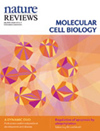2021年最新SCI期刊影响因子查询系统
NATURE REVIEWS MOLECULAR CELL BIOLOGY 期刊详细信息
基本信息
|
期刊名称

|
NATURE REVIEWS MOLECULAR CELL BIOLOGY NAT REV MOL CELL BIO |
|---|---|
| 期刊ISSN | 1471-0072 |
| 期刊E-ISSN | 1471-0080 |
|
2023-2024最新影响因子
(数据来源于搜索引擎)
|
81.3 |
| 最新影响因子 | 截止2024年3月26日:88.923 |
| 五年影响因子 | |
| JCI期刊引文指标 | 8.76 |
| 期刊官方网站 | https://www.nature.com/nrm |
| 是否OA | |
| 出版商 | Springer Nature |
| 出版周期 | Monthly |
| 始发年份 | 2000 |
| 年文章数 | 52 |
| Gold OA文章占比 | 1.37% |
|
研究类文章占比:
文章 ÷(文章 + 综述)
|
1.92% |
| 收稿范围 | ENGLAND |
| 期刊投稿网址 | https://mts-nrm.nature.com/ |
CiteScore
| CiteScore | SJR | SNIP | CiteScore排名 | ||||||||||||
|---|---|---|---|---|---|---|---|---|---|---|---|---|---|---|---|
| 173.60 | 35.910 | 19.301 |
|
WOS期刊SCI分区 (2023-2024年最新版)
| 按JIF指标学科分区 | 收录子集 | JIF分区 | JIF排名 | JIF百分位 |
| 学科:CELL BIOLOGY | SCIE | Q1 | 1/205 |
|
| 按JCI指标学科分区 | 收录子集 | JCI分区 | JCI排名 | JCI百分位 |
| 学科:CELL BIOLOGY | SCIE | Q1 | 3/205 |
|
中国科学院SCI期刊分区(2023年12月最新升级版)
| 大类学科 | 小类学科 | Top期刊 | 综述期刊 | ||
|---|---|---|---|---|---|
| 生物学 1区 |
| 是 | 是 |
中国科学院SCI期刊分区(2022年12月升级版)
| 大类学科 | 小类学科 | Top期刊 | 综述期刊 | ||
|---|---|---|---|---|---|
| 生物学 1区 |
| 是 | 是 |
中国科学院SCI期刊分区(2021年12月旧的升级版)
补充信息
| 2023-2024自引率 | 0.40% | |
|---|---|---|
| H-index | 386 | |
| SCI收录状况 | Science Citation Index Expanded (SCIE) (2020年1月,原SCI撤销合并入SCIE,统称SCIE) Scopus (CiteScore) |
|
| 官方审稿时间 | 较慢,6-12周 |
|
| 网友分享审稿时间 | ||
| PubMed Central (PML) | http://www.ncbi.nlm.nih.gov/nlmcatalog?term=1471-0072%5BISSN%5D | |








